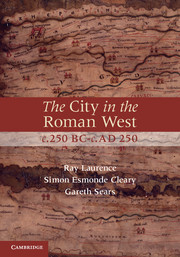Book contents
- Frontmatter
- Contents
- Illustrations
- Preface
- Introduction
- 1 The creation of an urban culture
- 2 Colonisation and the development of Roman urbanism
- 3 City foundation, government and urbanism
- 4 The reception of Roman urbanism in the West
- 5 Town planning, competition and the aesthetics of urbanism
- 6 Defining a new town: walls, streets and temples
- 7 Assembling the city 1: forum and basilica
- 8 Assembling the city 2: baths and urban life
- 9 Assembling the city 3: theatres and sacred space
- 10 Assembling the city 4: amphitheatres
- 11 The Roman city in c. AD 250: an urban legacy of empire?
- Bibliography
- Index
11 - The Roman city in c. AD 250: an urban legacy of empire?
Published online by Cambridge University Press: 05 June 2012
- Frontmatter
- Contents
- Illustrations
- Preface
- Introduction
- 1 The creation of an urban culture
- 2 Colonisation and the development of Roman urbanism
- 3 City foundation, government and urbanism
- 4 The reception of Roman urbanism in the West
- 5 Town planning, competition and the aesthetics of urbanism
- 6 Defining a new town: walls, streets and temples
- 7 Assembling the city 1: forum and basilica
- 8 Assembling the city 2: baths and urban life
- 9 Assembling the city 3: theatres and sacred space
- 10 Assembling the city 4: amphitheatres
- 11 The Roman city in c. AD 250: an urban legacy of empire?
- Bibliography
- Index
Summary
This book began with an account of the formation of Roman urbanism in the late third and early second centuries BC and the following chapters, as in other books on the Roman city, have focussed on the dates of the establishment of cities and monumental development. The latter could be regarded as having produced an urban culture across the Empire, but the previous chapters have shown a dramatic variation in the adoption, deployment and building of monument-types across the provinces of the Roman West. We must now turn to the outcome of this process of urban formation and account for the variations within Roman urbanism across the western Empire. More important, perhaps, is our intention to produce an understanding of the overall pattern of urbanism and to develop a macro-theory of Roman urban development that includes cities from right across the Roman West, rather than focussing on a single monument-type or province or the evidence from a single modern geographical region that coincides with a nation state. Unlike other accounts of the pattern of urbanism, we are less concerned here with the initial phase or adoption of the idea of having a town, and focus our discussion on the sustainability of Roman urbanism over the longer term or longue durée.
- Type
- Chapter
- Information
- The City in the Roman West, c.250 BC–c.AD 250 , pp. 285 - 319Publisher: Cambridge University PressPrint publication year: 2011



